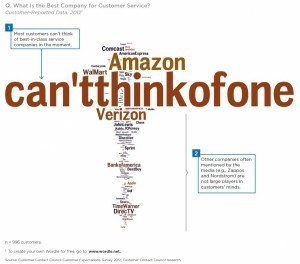Brent Adamson's Blog, page 22
September 12, 2012
And The Best Company for Service Is…
 This is a guest post by Pete Slease of the Customer Contact Council, our sister program for call center and customer service functions. We’ve modified it a bit for a sales audience. Visit the original here!
This is a guest post by Pete Slease of the Customer Contact Council, our sister program for call center and customer service functions. We’ve modified it a bit for a sales audience. Visit the original here!
This year, CCC asked nearly 1,000 customers the question, “What is the best company for customer service?” and the most popular response was:
Can’tthinkofone
If you’re having trouble reading that response, it’s “Can’t think of one”.
CCC decided to take the verbatim responses from a recent customer survey and enter them into a program to create a word cloud. If you’ve never seen a word cloud before, it’s a pretty cool program that shows the frequency of the use of words by the size of the font of those words. So, the more frequently a word or words are used, the bigger the font is in the word cloud. And when CCC entered the responses into the word cloud program, the largest response was “Can’t think of one”. Not Amazon or Zappos or Nordstrom. It was, “You know, I can’t think of one”.
Think about that for a minute…when we asked nearly 1,000 customers to tell us who is the best company for providing customer service, the #1 answer on the board by far was “Can’t Think of One”.
Now this was really surprising to us…we expected to see a bunch of the companies that often get publicized for providing superior customer service.
Admittedly, Amazon gets a lot of buzz, and their name was fairly big in the word cloud … but “Can’t Think of One” absolutely crushes them in terms of size. In fact, those companies that are often spoken about in the media and that we, as service executives, tend to think of as being the gold-standard, actually didn’t pop up very often at all.
And in a time when many executives and their teams are developing strategy for the next year, this is a pretty heartening piece of data. From the customer’s perspective, as products and service tends to seem exceedingly similar across suppliers, it is no surprise that the supplier’s ability to deliver insight drives the greatest loyalty impact. We call this ability to teach customers a new way to think about their business, Commercial Teaching.
What do you think? Is this good news, or troubling? Let us hear from you.
SEC Members, learn more about commercial teaching and the components of world-class insight. Also see how to identify your unique strengths and create a compelling commercial teaching pitch.
September 11, 2012
Getting Challenger Skills to Stick
 Over the last few years, we’ve worked with countless members on their journey to become a Challenger sales organization. Through these interactions, we’ve learned that to develop a sustainable Challenger sales force companies need to first ensure reps understand, accept, and are comfortable with Challenger behaviors—and most importantly—appreciate just how different Challenger skills are from current practice.
Over the last few years, we’ve worked with countless members on their journey to become a Challenger sales organization. Through these interactions, we’ve learned that to develop a sustainable Challenger sales force companies need to first ensure reps understand, accept, and are comfortable with Challenger behaviors—and most importantly—appreciate just how different Challenger skills are from current practice.
Why? Because Challenger skills (i.e., the ability to teach for differentiation, tailor for resonance, and take control of the sale) are tacit in nature, and therefore require a different-in-kind approach to be taught effectively.
Often, companies approach Challenger skills as if it were any other change management initiative they’ve rolled out in the past; develop one or two robust training sessions and assume it will be enough to get the job done. But, not only can Challengers not be built in a day (it requires dedication, planning, and skill certification to ensure success), traditional training engagements often fail to account for the key principles of building tacit skills:
Ensure reps are open to change
Make tacit skills tangible
Engineer a safe environment for practice
We’ve found that the best organizations use an approach akin to a boot camp to develop tacit skills in their sales people. They systematically:
Break Down Rep Confidence—Lead reps to self-discover the weaknesses of their current approach to not only drive their willingness to change, but to also make the skill gaps to close explicit.
Build Reps Back to Assuredness—Use training, coaching, and opportunities for practice in a safe learning environment to build rep confidence in, and ensure adoption of, newly learned skills.
One of the most important aspects of developing tacit skills, especially when it comes to Challenger skills, is providing reps with a safe environment for practice. St. Jude Medical’s Realistic Role-Play Program is a world-class example of how companies can not only instill new skills, but also help reps realize they can successfully embody behavior they once perceived as too difficult without putting any commercial relationships at risk.
St. Jude Medical’s role-plays recreate real-life pressure for reps, increasing the likelihood they will not revert back to old behaviors under the pressure of an actual customer situation. To simulate a sales visit with a high degree of reality, St. Jude Medical engineered the role-plays to involve:
Someone the rep doesn’t know, forcing reps to take the role play more seriously
Someone the rep will be intimidated by, better replicating the fear of an actual customer situation, placing reps outside of their comfort zone
Someone with the knowledge to respond as a customer would, increasing authenticity of role-play dialogue and question sets
SEC Members, to learn more about developing a Challenger Sales organization, check out the Challenger Rep Starter Kit and visit the Challenger Selling resource center. Also, to learn more about how St. Jude designed it’s Realistic Role-Play Program, view the full case or listen to the webinar we hosted with the program’s creators.
September 9, 2012
Are Your Reps’ Personal Brands Visible Online?
 Like it or not, social media is here to stay. And I’m not talking about Facebook. The fact is customers go to a number of places online to learn from and interact with peers and industry experts—discussion forums for industry or trade groups, or online communities in LinkedIn, for example.
Like it or not, social media is here to stay. And I’m not talking about Facebook. The fact is customers go to a number of places online to learn from and interact with peers and industry experts—discussion forums for industry or trade groups, or online communities in LinkedIn, for example.
This reality leads every company to ultimately ask themselves a hard question: just how much should we enable our reps to interact with customers online? Should we really enable them to build their own personal brand?
The answer, in short, is that you have to. It’s the only way you’ll succeed if you want to win the information battle. Allow me to explain…
Ten years ago, if you wanted to learn something new, you went to a conference or an industry/trade show. Nowadays, if you want to learn something, you turn on your iPad, grab your smart phone, or turn on your computer, and ask your social network or search for relevant blog posts or discussion groups. If you find something interesting and want to know more about an author, you look them up on LinkedIn and find a mutual connection. A couple email exchanges later, and that “expert” whom you’ve never met has now opted in to your personal network.
To complicate things, we’ve shifted from a world of information scarcity, to a world of information excess. Given the massive amount of information available today, learning in the social world is less about what to read and more about what not to read. As a result, virtually all of us have developed filtering techniques to screen out the noise, and identify only the most valuable information.
And in the social world, more than anything else, that filter is a recommendation from a person we trust—someone who’s demonstrated good judgment in the past in passing along information.
In the social world, organizations are almost inevitably and automatically filtered out, as they’re perceived to have an agenda. A person, on the other hand, with a demonstrated track record of directing me to valuable information worth my time, is someone I’m more likely to listen to.
Learning in a social world is about people learning from people. Where learning used to be sporadic and impersonal, today learning is ongoing and highly personal.
So, in this world, Marketing is going to have to place social interactions in the hands of actual people, i.e., individual sales reps. And Sales, consequently is going to have to train those reps to use information wisely, to build a community of trust in which they’re seen as an effective judge of everyone’s time, passing on only the kind of information customers are likely to find worthy of their attention. To create, develop, and grow a personal brand that is consistent with the brand of the company.
Now there is a right way and a wrong way to enable your reps to do this. It turns out, there is a LOT of support, guidance, and direction that a company must provide to a sales force. IBM would tell you that you have to go as far as to tell your reps where and with whom to engage, how to engage, and even what to say.
Some industries will be handcuffed by regulations, especially healthcare and financial services. But since we first unveiled the finding, we’ve even found financial services institutions that allow their reps to interact with customers where they learn online (of course within the bounds of what is legally permissible).
But even in non-regulated industries, we see a very broad spectrum of reactions. Some organizations are far down the path of helping reps build their personal brands; other companies view that as tremendously risky. Most companies are somewhere in between—they acknowledge that the world is moving online, and there’s a safe ground where their reps can succeed with a little bit of guidance. But the only way to do so is to enable sales reps to be people interacting with other people.
What does your company think about interacting with customers where they learn online? Do you enable reps to interact with customers online? If not, how is your company currently thinking about it?
SEC Members, read the full findings of the study and listen to the webinar replay. Also, see how Eloqua positions reps as influencers within their customers’ social network and IBM arms reps with “social soundbites” that help sales reps engage customers’ social networks.
Is Your Reps’ Personal Brand Visible Online?
 Like it or not, social media is here to stay. And I’m not talking about Facebook. The fact is customers go to a number of places online to learn from and interact with peers and industry experts—discussion forums for industry or trade groups, or online communities in LinkedIn, for example.
Like it or not, social media is here to stay. And I’m not talking about Facebook. The fact is customers go to a number of places online to learn from and interact with peers and industry experts—discussion forums for industry or trade groups, or online communities in LinkedIn, for example.
This reality leads every company to ultimately ask themselves a hard question: just how much should we enable our reps to interact with customers online? Should we really enable them to build their own personal brand?
The answer, in short, is that you have to. It’s the only way you’ll succeed if you want to win the information battle. Allow me to explain…
Ten years ago, if you wanted to learn something new, you went to a conference or an industry/trade show. Nowadays, if you want to learn something, you turn on your iPad, grab your smart phone, or turn on your computer, and ask your social network or search for relevant blog posts or discussion groups. If you find something interesting and want to know more about an author, you look them up on LinkedIn and find a mutual connection. A couple email exchanges later, and that “expert” whom you’ve never met has now opted in to your personal network.
To complicate things, we’ve shifted from a world of information scarcity, to a world of information excess. Given the massive amount of information available today, learning in the social world is less about what to read and more about what not to read. As a result, virtually all of us have developed filtering techniques to screen out the noise, and identify only the most valuable information.
And in the social world, more than anything else, that filter is a recommendation from a person we trust—someone who’s demonstrated good judgment in the past in passing along information.
In the social world, organizations are almost inevitably and automatically filtered out, as they’re perceived to have an agenda. A person, on the other hand, with a demonstrated track record of directing me to valuable information worth my time, is someone I’m more likely to listen to.
Learning in a social world is about people learning from people. Where learning used to be sporadic and impersonal, today learning is ongoing and highly personal.
So, in this world, Marketing is going to have to place social interactions in the hands of actual people, i.e., individual sales reps. And Sales, consequently is going to have to train those reps to use information wisely, to build a community of trust in which they’re seen as an effective judge of everyone’s time, passing on only the kind of information customers are likely to find worthy of their attention. To create, develop, and grow a personal brand that is consistent with the brand of the company.
Now there is a right way and a wrong way to enable your reps to do this. It turns out, there is a LOT of support, guidance, and direction that a company must provide to a sales force. IBM would tell you that you have to go as far as to tell your reps where and with whom to engage, how to engage, and even what to say.
Some industries will be handcuffed by regulations, especially healthcare and financial services. But since we first unveiled the finding, we’ve even found financial services institutions that allow their reps to interact with customers where they learn online (of course within the bounds of what is legally permissible).
But even in non-regulated industries, we see a very broad spectrum of reactions. Some organizations are far down the path of helping reps build their personal brands; other companies view that as tremendously risky. Most companies are somewhere in between—they acknowledge that the world is moving online, and there’s a safe ground where their reps can succeed with a little bit of guidance. But the only way to do so is to enable sales reps to be people interacting with other people.
What does your company think about interacting with customers where they learn online? Do you enable reps to interact with customers online? If not, how is your company currently thinking about it?
SEC Members, read the full findings of the study and listen to the webinar replay. Also, see how Eloqua positions reps as influencers within their customers’ social network and IBM arms reps with “social soundbites” that help sales reps engage customers’ social networks.
August 28, 2012
Salesforce Chatter: Bringing Social to Sales

By Miranda Weigler and Erin Frager
(This is the fifth post in our series on sales organizations’ emerging use of social media as a channel for shaping demand.)
Anyone in a company that uses Salesforce is acquainted with ‘Chatter’, the social function enabled by the CRM software. Although the feature has existed for two years, the adoption rate is slow and much of the initial excitement has fizzled to rumors of “just another social media outlet.”
Chatter offers a wealth of possibilities. The software includes a monstrosity of “apps”, real-time updates, and networking capabilities. It has the ability to form communities of internal and external stakeholders, allowing collaboration with privacy and security. Chatter use also reduces reliance on email; good for overloaded inboxes. In theory, it sounds perfect—but how do we get users to feel the same way?
The difficulty is predicated on one thing: buy in. In most cases it is a well communicated commitment from the top. In speaking to our members, we’ve discovered that a stakeholder or multi-disciplinary team that understands the value of Chatter and can communicate this around the organization makes all the difference.
We’ve also heard feedback equating Chatter to a “Facebook for the workplace”, implying that no work is actually getting done. What people don’t need is another channel to talk about their weekend plans or to share a picture of their kid. It may be difficult to get acceptance on Chatter if employees are seeing it as a haphazard social forum. Make sure that the management is expressing and demonstrating the benefits and value of Chatter as a company or department collaboration tool.
Using “groups” within Chatter can be beneficial. Users can subscribe to updates and posts they’d like to continually receive while avoiding internal spam. We are certainly not strangers to a cluttered inbox, so being able to filter topics will ease the minds of those hesitant to conform. Similarly, group messages only reach those who are members, further decreasing the volume of batch emails.
The embracing of #hashtags and @mentions is also key for posts on Chatter so that responses and comments are easily categorized. As Chatter carries the same robust security as its owning CRM system, it provides a safe platform for sharing without worries around organization privacy.
If you’ve got a strategy or story of CRM or Salesforce Chatter specific adoption, we’d love to hear it. Alternatively, what other tools do you use to drive collaboration in your organization?
SEC Members, see tips for successful tool adoption, next-gen CRM strategy, and our new Playbook for Social Media. Also, register for our upcoming webinar to see how IBM is Revolutionizing Social Selling.
The Most Annoying Corporate Buzzwords
 (This is a guest post by Jeff Schott of the Communications Executive Council, SEC’s sister program for heads of PR and corporate communications. Visit the original here!)
(This is a guest post by Jeff Schott of the Communications Executive Council, SEC’s sister program for heads of PR and corporate communications. Visit the original here!)
Recently I stumbled across this post from Forbes about the Most Annoying, Pretentious And Useless Business Jargon. It’s a fun read for anyone who has spent time in the corporate world, particularly those of us who work in corporate communications and are bombarded by jargon everyday.
Like it or not, corporate meetings and conference calls have become infested with buzzwords. We’ve all experienced it (probably even today!)—the annoying and detrimental rambles of a speaker who wants to appear to being saying something relevant, but in fact has zero meaning behind his statement, like a hack magician fumbling to pull a rabbit out of a seemingly empty hat. But just as any sensible person knows that there is a false bottom in the “magical” hat, we communicators—and I’d like to think most competent business professionals—can spot a cheap trick a mile away and properly view jargon for what it really is—sloppy, imprecise, and lazy.
There are a handful of words that made Forbes’ list that would definitely find their way onto my list of top offenders: “reach out”, “leverage”, “learnings”. I would have added a couple more which consistently strike a dissonant chord with me — “align” and “synergies” are two words that, at a previous job, I’d hear at least three or four times per meeting…often crammed into the same sentence. For example:
“Reach out to So-And-So to align on the initiative to spot potential synergies and leverage best practices.”
Do what?? I surely don’t know and, I bet, neither do you!
The article got me thinking about words/phrases like “best practice” where there’s a specific meaning intended, but due to inaccurate (over)use have become toxic to the ear. It’s kind of like that great new song that finds its way onto every annoying commercial on television. You hear it five times a day–every single day– so that, after awhile, it becomes so overplayed that you grow to despise it.
But it’s not the word’s fault, right? Should we blame the corporate jargon or the person saying it?
So for all you corporate jargon-heads, here’s a solution to help you change your evil ways. At CEC, we’ve done some work aimed at helping folks communicate more clearly and effectively. The key questions to ask: What words would our audience naturally use to talk about the topic? Is what we are saying relevant and emotionally engaging? Is it unique and memorable? Is it motivational (i.e. does it lead to specific action being taken)? Keeping these questions in mind is an easy way to reduce the buzzword quotient in your next meeting.
What about you? What words really vex you?
SEC Members, learn more on how to craft a compelling commercial teaching message.
August 27, 2012
Making Cross-Silo Sales Work
 Growing sales complexity requires business units and functions to often work together to fulfill customer needs. That said, few companies have an established process for cross-silo deal consideration that prioritizes company interests over those of a single silo. With so many parties involved, it is easy to exhaust resources on deals that lack potential, while letting good deals slip through the cracks.
Growing sales complexity requires business units and functions to often work together to fulfill customer needs. That said, few companies have an established process for cross-silo deal consideration that prioritizes company interests over those of a single silo. With so many parties involved, it is easy to exhaust resources on deals that lack potential, while letting good deals slip through the cracks.
In many organizations, the challenge stems much deeper—non-Sales silos lack customer focus and de-emphasize customer-need fulfillment, thereby limiting profit growth opportunities.
How then do the best companies drive cross-silo collaboration and commitment on deal requirements?
Our search led us to Alcatel, a global telecommunications company, which uses standardized decision templates to secure enterprise-wide commitment to execute on deal requirements. Using a tiered approach, Alcatel was able to involve all relevant stakeholders in the decision, while ensuring the best interests of the larger enterprise as the deciding factor in approving deals.
Alcatel uses the following three-step process to engage business units:
Sales Prequalification: Reps use a standardized scorecard to assess individual opportunities from an enterprise-wide perspective. The scorecard forces reps to think beyond simply driving sales volume to anticipating and evaluating potential deal complications.
Business Unit Assessment: Opportunities shortlisted by reps are sent to business units to perform due diligence. By evaluating a deal on multiple levels, Alcatel provides an opportunity to resolve conflicts that arise if a deal benefits one BU, but adversely affects another.
Enterprise-Wide View: Business units’ assessment of the deal’s viability is aggregated to arrive at an enterprise-level perspective necessary to make a go/no-go decision. When business units are unable to agree on an opportunity, the deal is escalated to a group of C-level executives.
The formalization of the approval process allowed Alcatel to not only improve its efficiency, but also its effectiveness. By agreeing to deals on the front-end, Alcatel’s business units are better able to focus on the execution of deals that are in the best interests of the enterprise as a whole.
SEC Members, to learn more, review Alcatel’s best practice on Solutions Commitment Templates.
August 21, 2012
Are Your Sales People in the Right Roles?
 Companies are constantly revisiting their competency models to make better decisions in recruiting, deploying and developing salespeople to over-perform in distinct roles. Recently, we discussed the common problems associated with the construction of competency models (excessively generic models, vaguely defined behaviors, and rigid models) and the detrimental effects of a poor model.
Companies are constantly revisiting their competency models to make better decisions in recruiting, deploying and developing salespeople to over-perform in distinct roles. Recently, we discussed the common problems associated with the construction of competency models (excessively generic models, vaguely defined behaviors, and rigid models) and the detrimental effects of a poor model.
In order to be most productive, sales people need to know what is expected of them in their role and what exactly they are going to be doing. Therefore, a good competency model must include:
The core competencies associated with and necessary for the role clearly and simply articulated
The specific skills that correspond to each role
The specific behaviors that are associated with each skill
In an effort to revamp their selling approach, IBM developed a highly successful competency model based on the characteristics of its top talent in order to encourage high-performance selling across its organization. The company assesses individuals through a wide variety of internal and external inputs in competency areas such as information seeking, personal insight and team orchestration.
IBM also developed a corresponding measurement tool to determine an individual’s proficiency in each of these areas. IBM recognized that each role within the sales force requires different skills and actions and so the general competency framework is adapted for each individual to focus on the relevant strengths for their role. Additionally, the information from the competency model is used to:
Inform areas for focus for an individual’s personal training and development
Determine the make-up of a team’s current and future staffing needs
Enable internal shifts so that the right person is in the right seat
Improve the overall caliber of the organization’s talent
As each competency was clearly defined and supported by a system for measurement, individuals were more accurately placed in the right job, improving overall sales productivity and performance. Ultimately, IBM’s competency model was so successful because it was easy to use, accurately reflected the expectations for each position and was tailored to the relevant skills and activities of each role.
SEC Members, learn more about how IBM developed its role-specific competency model. Also review other world-class practices on sales competencies and Challenger specific competency models.
Executing Change: The Shift from Solution Sales
 There is no escaping the fact that change is a natural part of organizational life. Today’s sales leaders are faced with the challenging task of transforming their organizations into insight selling organizations in order to better position their salespeople to succeed in an increasingly complex selling environment.
There is no escaping the fact that change is a natural part of organizational life. Today’s sales leaders are faced with the challenging task of transforming their organizations into insight selling organizations in order to better position their salespeople to succeed in an increasingly complex selling environment.
If you are contemplating the end of solutions sales, and feeling puzzled about strategies to help your sales force adapt, you are not alone! Executing change is difficult, and here are a few reasons why:
In a world of limited resources (budgets, people, time), it is hard to balance immediate business needs (meeting targets) with long-term demands (developing insight capabilities).
People often act as barriers to adaptability. Your sales force is likely biased towards the current sales methodology and optimistic about the future, which makes any change seem less urgent.
Key internal stakeholders often have conflicting constrains. Creating leadership alignment around a shared vision for change within an organization can be challenging.
Every sales organization will face different barriers to change, just as every organization finds itself in a different stage of the transformation away from solution sales. Regardless of where you are in the process, you can be sure that executing change will require broad organizational commitment. Change initiatives often do fail to achieve the intended objectives, and as you might expect, implementation shortfalls are usually listed as the reason why. To avoid the implementation trap consider the following:
Establish a sense of urgency. Don’t assume that reps understand the business case for change.
Develop an articulated vision. Create a two-sentence description of the change objective you hope to accomplish in your organization, and arm sales managers with effective language they can use to communicate with reps.
Create a change coalition and develop champions for your cause. Mobilize people within the organization and consider hiring or nominating a change leader who can deliver the change.
Over communicate with your sales force. Most change management initiatives follow the pattern of building awareness, understanding, acceptance, and commitment. Creating an effective communication strategy will help move your sales force through these stages and drive adoption.
Quickly address change resisters, and publically reward and recognize change adopters.
Anchor change in your company’s corporate culture, and embed your change in impactful organizational activities (e.g. training, recruiting, compensation, etc.)
Align your performance management processes, sales organizational structure, and job descriptions with the new vision to reinforce the change initiative.
Have you been through or recently executed a change initiative? What suggestions do you have for successfully executing change and avoiding common implementation mistakes?
SEC members, learn what the 10 trends sales executives must know about in 2012 are, and learn more about how to sell the way customers want to buy in the insight selling era.
August 20, 2012
Deal Desks: The Hottest New Sales Function
 Let’s face it: deals are not becoming smaller or simpler. In fact, growing demands for customization from buyers have increased both deal size and complexity, prompting many sales organizations to consider the creation of a deal desk that advises and supports field sales on deal economics.
Let’s face it: deals are not becoming smaller or simpler. In fact, growing demands for customization from buyers have increased both deal size and complexity, prompting many sales organizations to consider the creation of a deal desk that advises and supports field sales on deal economics.
Over a year ago, SEC conducted a deal desk survey to gather benchmarking information on what they do, where they are located, who has them, and why they are increasing in popularity. The results from this survey indicated that 35% of respondents were in the ‘planning’ stages of a deal desk.
As deal desks continue to gain popularity, we have chosen to re-visit the topic and conduct a fresh survey about their function and organization within companies. If you have a deal desk function or are planning to launch a deal desk, please click here to take our updated survey!
Our last survey uncovered several interesting facts about the role of deal desks:
What do deal desks do?
Some traditional deal desk duties include approving non-standard deals, establishing pre-set discount levels, and working with cross-functional stakeholders on deal solutions.
What are newly-established deal desks doing differently than older deal desks?
Newer deal desks focus on equipping field reps with sales enablement tools and market trend analysis that provide visibility into all the variables impacting deal profitability.
What is used to measure deal desk success?
The majority of sales organizations measure deal desk effectiveness by increased deal profitability, higher gross revenue/volume, and lower sales cycle time.
SEC Members, click here to access the results of our last deal desk survey. If you’re interested in the topic of deal desks, please complete our latest survey, the results of which will be previewed in an upcoming webinar on October 9, 2012 (click here to register for the webinar).
Brent Adamson's Blog
- Brent Adamson's profile
- 9 followers



